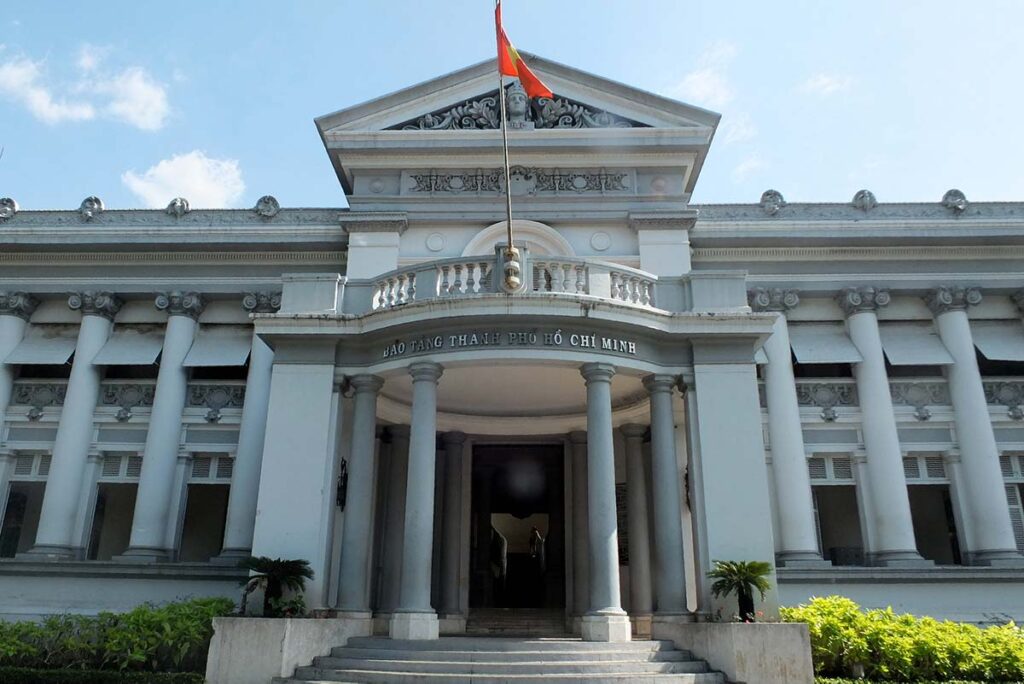Located in a historic colonial building, the Ho Chi Minh City Museum itself is a testament to the city’s rich history. Inside you will learn from its humble beginnings as a trading port and its flourishing handicraft traditions to the turbulent era of the Vietnam War and its present-day vibrancy. The museum offers a comprehensive exploration of the city’s diverse and evolving history.
Visiting information
- Opening Times: The Ho Chi Minh City Museum is open from Monday to Sunday, from 8:00 AM to 5:00 PM.
- Address: The museum is located at Nguyen Binh Khiem Street, District 1, Ho Chi Minh City, Vietnam.
- Entrance Fee: 30,000 VND
Located in the heart of Ho Chi Minh City, the museum’s central location makes it easily accessible. To get there, it is best to take a taxi or ride-sharing service. Additionally, the museum is within walking distance of many popular landmarks and attractions in the city.
History of Gia Long Palace
The Ho Chi Minh City Museum, formerly known as Gia Long Palace, was constructed in 1885 by the esteemed French architect Alfred Foulhoux. This magnificent building was originally intended to house the Museum of Commercial Trade, showcasing the vibrant products and goods of Southern Vietnam. However, its purpose soon shifted, and it became the residence of the Governor of Cochinchina.

Throughout the tumultuous years that followed, the palace witnessed significant changes in control. During the Japanese occupation of French Indochina, it served as the residence for Japanese Governor, marking a brief chapter of foreign influence. As the political landscape continued to evolve, the palace found itself under the control of various governing bodies, including the puppet Empire of Vietnam government and the Provisional Government of the State of Vietnam.
In the years that led up to and followed the Vietnam War, the palace played a pivotal role in the political arena. It served as the headquarters for the Provisional Government of the State of Vietnam and later became the official residence of the Premier of the State of Vietnam.
In 1978, after the North Vietnamese communist invasion of South Vietnam, the palace was designated as the Ho Chi Minh City Revolutionary Museum. Its purpose was to preserve and present the rich revolutionary heritage of the city. Over time, the museum’s exhibits and collections expanded, encompassing not only the revolutionary struggles but also the city’s archaeological roots, its role as a bustling trade port, the intricacies of its handicraft traditions, and the profound impact of the Vietnam War.
Today, the Ho Chi Minh City Museum stands as a testament to the resilience and transformation of the city, offering you a captivating journey through its historical narrative.
Ho Chi Minh City Museum exhibition
Inside the Ho Chi Minh City Museum, you will find 9 galleries, each offering a glimpse into different historical periods and contributing to a comprehensive understanding of the city’s development.
The Nature-Archaeology gallery has lots of of images, artifacts, maps, and diagrams that showcase the geological structure, topography, climate, rivers, animals, plants, and mineral resources of the region, providing insights into its natural heritage.
The Geography-Administration exhibition delves into the history of Saigon’s formation and development since 1698. Through a collection of maps, graphs, and pictures, you can explore the city’s evolving landscape and administrative transformations over time.

In the Trade Port-Trade-Service gallery, you are introduced to Saigon’s role as an economic center for the southern region and the entire country. Referred to as the “Pearl of the Far East,” the exhibition highlights the city’s significance as a hub of commerce and services.

The Industry-Handicraft exhibition offers an overview of traditional handicraft industries that continue to thrive in Ho Chi Minh City. It provides a glimpse into the city’s historical and contemporary industrial landscape, showcasing the evolution of its manufacturing and production sectors.
The Culture of Saigon-Ho Chi Minh City gallery immerses you in the rich traditions, rituals, beliefs, and traditional arts of the city. It celebrates the cultural heritage of Saigon-Ho Chi Minh City, exemplifying the vibrant and diverse expressions of Vietnamese national identity.
The Revolution Struggle (1930-1945) exhibition displays over 300 artifacts, pictures, and documents that chronicle the resistance war against the French colonial rule, starting from the Communist Party’s inception to the momentous victory at Dien Bien Phu.

Continuing the narrative, the Revolution Struggle (1954-1975) gallery reconstructs the path to victory achieved by the Vietnamese people under the leadership of the Communist Party and President Ho Chi Minh. It illustrates how their unwavering determination led to the French and US governments acknowledging Vietnam’s independence, sovereignty, unity, and territorial integrity.
The Souvenirs of War Resistance exhibition presents over 250 original artifacts, documents, pictures, and sketches, offering a profound exploration of the individuals and events associated with the resistance war to safeguard the country’s freedom and independence.
The Vietnam Currency gallery provides you with a fascinating glimpse into the country’s monetary history. With a collection of over a thousand coins and banknotes from different periods, the exhibition offers a closer look at the evolution of Vietnamese currency and its significance in the economic landscape.
Other things to do around the museum
The Ho Chi Minh City Museum (Gia Long Palace) enjoys a prime central location. In close proximity, you can explore the historic colonial charm of People’s Committee Building on Nguyen Walking Street, marvel at the grandeur of the Saigon Opera House, and delve into the rich history of the Independence Palace. With the Saigon Notre Dame Cathedral and Saigon Central Post Office just a short stroll away, this captivating neighborhood offers a nice blend of modern skyscrapers, old-world architecture, cultural landmarks, and inviting coffee shops, making it an ideal area for a full day of exploration.



